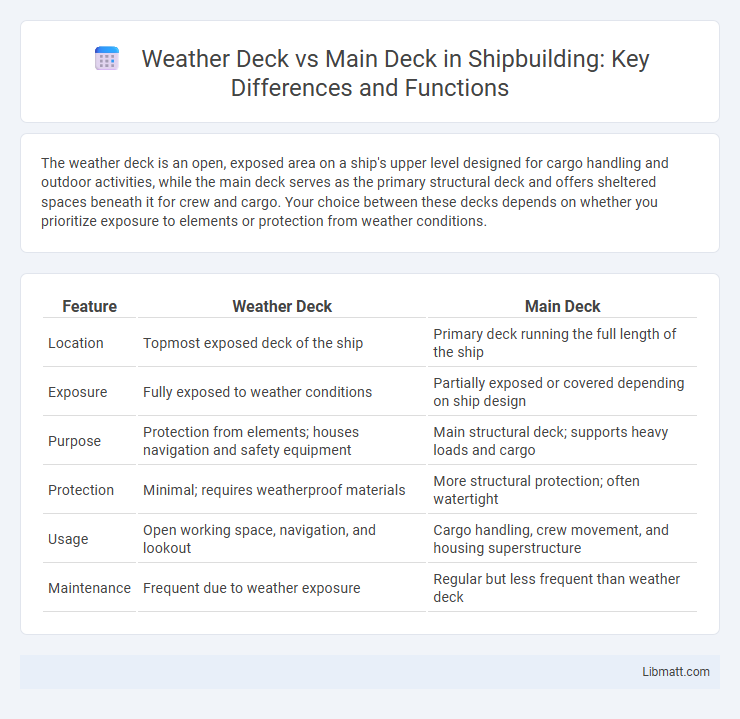The weather deck is an open, exposed area on a ship's upper level designed for cargo handling and outdoor activities, while the main deck serves as the primary structural deck and offers sheltered spaces beneath it for crew and cargo. Your choice between these decks depends on whether you prioritize exposure to elements or protection from weather conditions.
Table of Comparison
| Feature | Weather Deck | Main Deck |
|---|---|---|
| Location | Topmost exposed deck of the ship | Primary deck running the full length of the ship |
| Exposure | Fully exposed to weather conditions | Partially exposed or covered depending on ship design |
| Purpose | Protection from elements; houses navigation and safety equipment | Main structural deck; supports heavy loads and cargo |
| Protection | Minimal; requires weatherproof materials | More structural protection; often watertight |
| Usage | Open working space, navigation, and lookout | Cargo handling, crew movement, and housing superstructure |
| Maintenance | Frequent due to weather exposure | Regular but less frequent than weather deck |
Understanding the Basics: What is a Weather Deck?
A weather deck refers to the uppermost deck of a ship that is exposed to the open air and weather elements, unlike the main deck which is often partially or fully enclosed. This open design allows rain, wind, and sunlight to directly impact the weather deck, making it essential for crew safety and proper equipment handling. Understanding the weather deck helps you recognize its role in ship operations and how it differs from the more protected main deck below.
Main Deck Defined: Key Features and Functions
The main deck is the principal deck of a vessel, extending from bow to stern and serving as the primary structural platform for cargo, equipment, and crew activities. Unlike the weather deck, which is exposed to the elements, the main deck often supports enclosed spaces below and provides structural integrity to the ship's hull. Understanding the main deck's key features and functions helps you appreciate its role in stability, safety, and operational efficiency aboard the vessel.
Structural Differences Between Weather Deck and Main Deck
The Weather Deck is an open, upper deck exposed to the elements, typically constructed with reinforced materials to withstand harsh weather conditions, unlike the Main Deck which is enclosed or partially enclosed for cargo and passenger protection. Structural differences include the Weather Deck's emphasis on drainage systems, non-slip surfaces, and corrosion-resistant coatings to handle rain, wind, and sunlight, while the Main Deck prioritizes load-bearing strength and structural integrity for heavy cargo and equipment. Understanding these differences ensures your vessel's design optimally balances durability, safety, and functionality across various maritime conditions.
Role and Importance of the Weather Deck in Ship Design
The weather deck serves as the uppermost exposed deck on a ship, crucial for withstanding harsh maritime conditions and protecting cargo and crew from the elements. Its design impacts the vessel's structural integrity, seaworthiness, and overall safety by providing essential drainage and stability features. Understanding the role of your ship's weather deck helps optimize performance and ensures compliance with international maritime safety standards.
Main Deck Functions in Ship Operations
The main deck serves as the primary working platform on a ship, supporting essential operations like cargo handling, crew movement, and equipment storage. It provides structural integrity and houses access points to lower decks, ensuring safe and efficient navigation through maritime environments. Your awareness of the main deck's multifunctional role is crucial for understanding overall ship management and operational safety.
Materials and Construction: Weather Deck vs Main Deck
Weather decks are typically constructed using corrosion-resistant materials such as marine-grade steel or aluminum alloys to withstand harsh environmental conditions like saltwater exposure and UV radiation. Main decks often utilize reinforced steel structures designed for heavy load-bearing capacities and structural integrity, incorporating additional layers like non-skid coatings for safety. Your choice between weather deck and main deck materials impacts durability, maintenance needs, and operational efficiency in maritime environments.
Safety Considerations for Weather Decks and Main Decks
Weather decks are exposed to external elements such as rain, wind, and waves, requiring non-slip surfaces and secure handrails to prevent accidents in harsh conditions. Main decks, typically enclosed or partially sheltered, benefit from better protection against environmental hazards but still demand proper drainage and fire safety measures to ensure crew safety. Both decks must comply with maritime safety regulations, including load limits and emergency escape routes, to minimize risks during vessel operations.
Maintenance Challenges: Comparing Weather and Main Decks
Weather decks face more frequent maintenance challenges due to constant exposure to harsh environmental elements such as UV rays, saltwater, and heavy rain, which accelerate wear and corrosion. Main decks, while better protected, require regular inspections for structural integrity and corrosion caused by operational stress and occasional exposure to weather. Effective maintenance plans must incorporate advanced corrosion-resistant coatings and frequent monitoring to prolong the lifespan of both weather and main decks.
Common Misconceptions About Weather Decks and Main Decks
Weather decks are often misconceived as separate or elevated structures, but they actually refer to the uppermost deck exposed to weather conditions, serving as a protective barrier for lower decks. The main deck is frequently mistaken for the highest deck, yet it typically runs continuously along the ship's length and provides primary structural strength. Understanding that the weather deck is designed primarily for external exposure while the main deck serves as a key load-bearing element clarifies their distinct roles in ship architecture.
Choosing the Right Deck for Specific Vessel Types
Selecting the appropriate deck type is crucial for vessel performance and functionality, with weather decks typically preferred for cargo and container ships due to their exposed, flat surface ideal for loading heavy equipment. Main decks, enclosed or partially covered, are favored on passenger vessels and military ships for enhanced protection and structural integrity. Understanding the vessel's operational environment and intended cargo ensures optimal deck utilization, balancing exposure and safety.
Weather deck vs main deck Infographic

 libmatt.com
libmatt.com